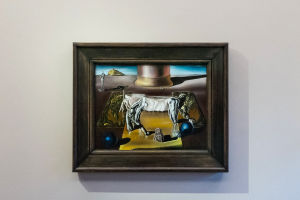When we think of Pablo Picasso, the first thing that might come to mind is his radical departure from classical forms of art.
Picasso's work, especially from his Cubist period, is famous for breaking the rules of realism and representing subjects in fragmented, abstract forms.
In contrast to traditional artwork that aimed to depict people and scenes in recognizable forms, Picasso's paintings seemed to move further and further away from representation. And yet, his art has achieved some of the highest auction prices in history. Why is it that the more "unlike" reality Picasso's paintings became, the more valuable they became?
This question delves into the cultural, psychological, and economic aspects of art and how the world came to view Picasso's radical break from tradition as a marker of genius rather than mere confusion. The answer lies not only in the technical aspects of his work, but in the evolution of how society values creativity and artistic vision.
From Realism to Abstraction: Picasso's Artistic Revolution
Before Picasso, art followed a long tradition of attempting to accurately represent reality. Artists worked under the assumption that the purpose of painting was to capture the world around them with as much detail and precision as possible. But Picasso, along with other avant-garde artists of the early 20th century, rebelled against this norm.
Starting in the early 1900s, Picasso began to explore new ways of representing reality that were abstract and distorted. His Cubist works, particularly "Les Demoiselles d'Avignon" (1907), shattered the conventional notions of perspective, proportion, and form. Faces and objects were broken up into geometric shapes, often leaving the viewer struggling to make sense of what they were seeing.
This wasn't just a random act of rebellion; it was a conscious effort to depict the complexities and multidimensionality of life. Picasso sought to represent the subject from multiple perspectives at once, giving a more holistic and fragmented view of reality. By rejecting the traditional artistic rules of representation, Picasso invited his viewers to think deeper about how they saw the world and what meaning could be derived from the act of perceiving itself.
The Value of Innovation: Breaking the Mold
So, why does innovation like this—where art becomes less like the world it is supposed to represent—end up being so highly valued? Part of the answer lies in the idea that scarcity and originality tend to make something more precious. When Picasso broke away from the norms, he created a new language of visual art, one that had never been seen before. This was not just a new technique; it was a new way of seeing, understanding, and experiencing the world through art.
Picasso's willingness to push boundaries allowed him to create something that stood out in a world full of traditional painters. Over time, his revolutionary approach to art became synonymous with his name, and people began to equate the "unlikeness" of his work with genius. In fact, some would argue that the very distance his paintings created from the world around us made them more valuable, as it demonstrated not only technical skill but also immense creative freedom.
The Economic Forces Behind Picasso's Art
Beyond just artistic innovation, Picasso's works have also been deeply influenced by market forces. Art, after all, exists in a marketplace, and that marketplace values both rarity and renown. Picasso's paintings are rare, not only because of their unconventional style, but also because they are original works that cannot be easily reproduced.
As the world started to recognize Picasso's genius, his art gained a reputation that contributed to its astronomical price tags. His works were no longer just seen as abstract paintings; they became investments in culture and history. Collectors, museums, and wealthy individuals wanted to own a piece of the art world's most radical transformation, and Picasso became a symbol of both artistic and financial prestige.
It also helps that Picasso created an immense body of work. From paintings to sculptures to ceramics, he left behind a legacy of art that allowed for a large number of works to be collected and sold over time. Each piece, being connected to the larger context of Picasso's career, has continued to gain value as his place in art history has solidified.
Why Do We Value the "Unreal" in Art? The Psychology Behind Abstract Art
One of the key reasons why Picasso's work became so valued is the deep psychological impact it has on its viewers. Traditional realism often comes with a sense of predictability and comfort—viewers recognize what they see, and that creates a sense of closure. But Picasso's abstract paintings challenge our perceptions. They force us to engage with the work and derive our own interpretations. The process of making sense of something unfamiliar can evoke a range of emotions, from confusion to wonder.
This psychological engagement is what makes Picasso's paintings so compelling. When people look at something "unlike" reality, they are encouraged to look beyond the surface and explore the meaning behind it. This deeper connection with the viewer, along with the work's ability to evoke strong emotions or questions, creates a sense of worth that transcends simple representation.
Furthermore, abstract works like Picasso's offer more open-ended interpretations. Unlike classical paintings that often have clear symbolism or a direct story to tell, Picasso's abstract art invites viewers to experience the piece in their own way, leading to a more personalized and profound connection with the art.
The Cultural Legacy of Picasso
Over the years, Picasso's works have become a symbol of cultural progression. His art represents more than just a departure from traditional painting techniques; it embodies the spirit of the 20th century, characterized by innovation, experimentation, and a questioning of established norms. As society embraced these changes, Picasso's work became a touchstone for those wanting to capture the energy of the era.
Today, Picasso is not just a name associated with modern art; he is a symbol of creativity itself. The more unconventional his work became, the more his name became tied to the idea of artistic liberation. And in this sense, the "unlikeness" of his paintings has only increased their value as time has gone on.
Picasso's work is a testament to the fact that art is not just about realism—it's about pushing boundaries, expanding our understanding, and inviting new ways of seeing the world. As his art became less "like" reality, it became more valuable because it challenged convention and forced viewers to rethink what art could be. In the case of Picasso, the value of his work isn't just found in the image itself, but in the depth of its intellectual and emotional resonance.
The more abstract and unconventional his art became, the more it became a reflection of creative freedom, making it all the more priceless in the eyes of collectors, historians, and art lovers around the world.


